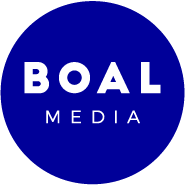
10 Essential Ingredients for Email Copywriting That Work
Over the years, myths and misconceptions have led many marketers to adopt bad habits and the wrong ideas about how to write effective, persuasive email marketing messages. We’ve often heard people say “don’t use the word ‘free’ in the subject line” or “the shorter the better,” but those are not always helpful or correct rules of thumb. At Boal Media, we’ve been studying what works for years and are happy to share what we’ve found to be the most important ingredients for strong email copywriting that drives results.
- Get people to open up. It’s the first crucial step towards having a successful email campaign. If your reader doesn’t open, then they will never see the rest of your message nor take any of the intended calls to action you included in your email. Invest the time to get it right.It’s helpful to think of the email FROM NAME and SUBJECT LINE as a mailing envelope and the email message as a letter. Then you can apply the same tried and true practices that direct mail has tested and applied for years.
- Your “From Name” will help your open rates if your brand has a reputation of reliability, honesty, and quality. Another reason why it’s important to nurture and protect your brand equity.
- The “From Name” is different from your email address and is what most people see in the name field when your email arrives in their inbox.
- Be consistent once you pick a “From Name” to continue building your brand reputation. Your “From Name” should be one your audience will recognize, be consistent with the brand they subscribed to, appear legitimate, and reflect your company’s name or a highly recognizable figure within your company.
When writing the subject line, here are a few guidelines:
-
- Word order matters. Front load your most important message as most people’s inboxes cut off your subject line at about 60 characters
- Be direct and allude to the message content. Clever but vague subject lines are generally less effective.
- Avoid asking Yes or No questions. “Find out” or “How to” approaches are stronger ways to entice readers to view your email content.
- Take advantage of the preheader, which will appear in people’s inboxes at the end of your subject line, to build on your subject line’s message.
- Deliver your subject line’s promise in the body copy. If your subject line over promises on what is in your message, overall conversions will suffer and you’ll lose audience trust.
- “Dear Jane” is okay, but don’t overuse it. When you use first name personalization, make sure the message contents are well targeted so people feel you are sincerely starting a conversation and have tailored your message to their needs or interests. [Avoid being overly salesy.] First name effectiveness will only boost your open rate the first time you try it if you abuse it.
- When writing the central body copy:
- Keep it simple and straightforward using as few words and sentences as possible to grab people’s attention quickly.
- Break up copy with headlines. Since most people scan, headlines should summarize the main point of each section. As on a website, this helps people to instantly understand your message. Dense paragraphs without headlines put a strain on your readers’ patience and interest.
- Include clear calls to action, such as buttons. With longer copy, it’s fine to include multiple calls to action or repeat the call to action in slightly different ways throughout the message.
- Be specific with your “call to action,” avoiding “click here” or “learn more.” A more tailored “ask” helps people to instantly understand why they should want to keep reading and further clarifies your message.
- Prioritize message flow, so that your main points are read first. See item number 4.
- Create a strong opening. Each sentence should be persuasive and build upon the main message.
- Long copy or short? If you’re introducing a new product or service, a longer email can work well, similar to a long scroll website that:
- Quickly and clearly states the primary problem you solve or the benefit your business will provide.
- Defines the features and ties back to the overall benefit.
- Includes “proof points” such as testimonials, third-party validation (awards, ratings, etc.), testing results, statistics are all good examples.
- Makes your “ask” and “call to action” uber-specific.
- Communicates your message as a compelling story.
- Focus on answering “what’s in it for them?” Each line should address this for your audience. If it doesn’t, leave it out. Take note of how often you’re using “me” and “I” vs. “you” and “your.” Talk to and about them, not about you.
- Be direct, informative, fun, and speak to the heart. Some people try to lead with clever, fun copy which doesn’t actually persuade them to read on. Being clever is not the same as inciting curiosity, so be sure your main message is clear and compelling from the start and conveys urgency. Then look for ways to incorporate some fun into your writing that enhances the main message. A little bit of humor helps humanize your message. Appeal to their emotions by tapping into their hopes, dreams, and fears.
- Don’t worry about avoiding “spam filter” words. Spam filters have become much more sophisticated than in the early days of email. Emails are most often flagged as spam today not because of the language you use, but because of how engaged your audience is with your message. If you send highly relevant, targeted messages, you’ll be fine using the word “free” as much as you need.
- Test and target! Start your testing with the subject line.
- We prefer split stream tests where a percentage of your list receives each version (A/B) and the remainder of the list receives the top performing option. This works best when your email subscriber list includes 5,000 emails or more since you’re then more likely to get results that are statistically significant. Be sure to measure the level of confidence using a statistical significance calculator.
- The more targeted you can be with your messaging, the better performance you’ll see. Personalize the messaging with their interests, profile, and anything else that’s going to make the message more relevant to your audience.
- P.S.: Take advantage of the power of the P.S. to reiterate your message. This is another direct mail tactic that works well in emails.
- The same proven direct mail copywriting principles also apply to email copywriting. Study the early trailblazers, such as John Caples and his classic Tested Advertising Methods for insights. Other books with spot-on insights include Adweek Copywriting Handbook, Ogilvy On Advertising, and Scientific Writing by Claude Hopkins.
Reach out if you’d like to discuss how your brand can improve their email marketing effectiveness. Each business has its own unique value proposition, voice, and messaging strategy that works best. Copy is just one of the key components of email marketing success. We’d love to help you tap into your winning formula.
Happy writing!



